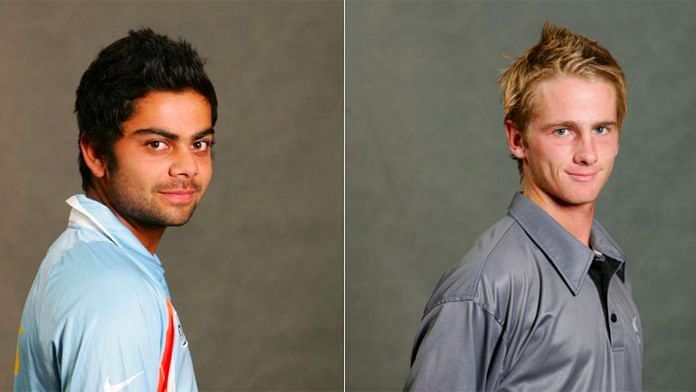New Delhi: When India and New Zealand take the field in the first ICC World Cup semi-final Tuesday, their captains, Virat Kohli and Kane Williamson, might experience déjà vu. Eleven years ago, the two had captained their countries in the ICC Under-19 World Cup semi-finals in Malaysia, with India emerging triumphant and going on to defeat South Africa for the cup.
New Zealand posted 205, and in a rain-affected game, India chased down an adjusted target of 191, with Kohli posting 43 after having picked up two wickets, including the key one of Williamson.
Three other cricketers who played in that semi-final are part of the squads this time around — all-rounder Ravindra Jadeja for India and pace bowlers Trent Boult and Tim Southee for New Zealand.
ThePrint looks at where the other players who took part in that game ended up.
India
Five members of India’s playing XI in that U-19 semi-final with New Zealand went on to represent the country at the international level —Kohli, Jadeja, Manish Pandey, Saurabh Tiwary and Siddarth Kaul.
It’s obvious that Kohli has turned out to be a remarkable player, not just among his peers but among Indian batsmen of all time. He has broken several batting records and recently became the fastest player to reach 20,000 international runs. In 77 Tests, Kohli has scored 6,613 runs at 53.76, while in ODIs, he has scored 11,285 runs in 235 matches at a mind-boggling average of 59.70. In T20 Internationals too, Kohli averages more than 50, having scored 2,263 runs in 67 matches.
Like Kohli, Jadeja, the joint-highest wicket taker for India at the tournament with 10, was fast-tracked into the senior national side. After a few false starts, he has emerged as an integral part of India’s lethal bowling line-up. With 192 wickets in 41 Tests, Jadeja is currently ranked the sixth best bowler in the world. He has also taken 175 ODI wickets in 152 matches, and 31 wickets in 40 T20Is. He is also handy with the bat, having scored 1,485 Test and 2,035 ODI runs. In T20Is, however, he has managed just 116 runs.
Pandey’s career has seen its share of ups-and-downs, but he has enjoyed some moments of glory playing for the India side.
Two years after the U-19 triumph, Pandey shot to fame by becoming the first Indian to score an IPL century in 2010. However, he had to do the hard yards in domestic cricket for Karnataka before getting called up for the national limited-overs sides in 2015.
Pandey’s most memorable knock was an unbeaten 104 against Australia in Sydney in 2016, helping India chase down 330. But he has struggled to cement his place in the team, with 440 runs in 23 ODIs at 36.66 and 538 runs in 28 T20Is at 41.38.
Kaul and Tiwary have played three ODIs each, with the former also featuring in three T20Is. Both have been notable IPL performers, though Kaul has only come into his own in recent seasons.
Most of the other players in the side for that semi-final against New Zealand have featured in the IPL — Iqbal Abdulla, Pradeep Sangwan, Taruwar Kohli, Shreevats Goswami and Tanmay Srivastava. Medium-pacer Ajitesh Argal also played the IPL and a few first-class games, but went on to become an income tax inspector through the sports quota.
For cricket trivia buffs, the name Napoleon Einstein will probably ring a bell. While he wasn’t part of the playing XI against New Zealand, he was noted for his unique name. He went on to play a couple of List A games for Tamil Nadu and also made the Chennai Super Kings squad, before fading into obscurity.
Also read: World Cup 2019 is showing that India has finally become a fast-bowling nation
New Zealand
Five players from New Zealand’s squad that day also later made it to the national team, led by Williamson, one of the most prolific batsmen the country has produced. The Kiwi skipper averages 53.38 in Test cricket, with 6,139 runs in 72 matches; he has also scored 6,035 runs in 147 ODIs at 47.89 and 1,505 runs at 31.35 runs in 57 T20Is.
Boult, who swings the ball at pace, has emerged as the leader of New Zealand’s potent pace attack, with 246 wickets in 61 Tests, 162 in 87 ODIs and 37 in 25 T20Is.
Southee, another swing bowler who has waned a bit in recent years, has bagged 244 wickets in 65 Tests, 186 in 140 ODIs and 67 in 58 T20Is.
Two other players from that U-19 side, Corey Anderson and George Worker, also went on to play for the Black Caps. All-rounder Anderson sensationally scored the then-fastest ODI century off 36 balls against West Indies in 2014, but has struggled with injuries and was not included in the current World Cup squad.
Worker played 10 ODIs and two T20Is, but after some middling performances, he failed to get a central contract for 2019-20.
Other players in the side for the semi-final never made it to the Black Caps, and some went on to work in other fields. Nick Beard, a spinner and a lower-order batsman, joined became a real estate professional, and now has his own website.
Fraser Colson was active in first-class cricket until 2018, but has now become a regulatory analyst at the Soma Group.
Michael Guptill-Bunce, a cousin of New Zealand opening batsman Martin Guptill, played for Auckland until late 2018, but is now working as an assistant facilities manager at CBRE Asia-Pacific.
Anurag Verma, who also played until 2018, became an engineer, and is now pursuing an MBA from Edinburgh Business School.
Michael Bracewell, a cousin of New Zealand international Doug Bracewell, is still an active cricketer, having played 75 first-class matches.
The present whereabouts of Greg Morgan could not be found. He last played first-class cricket in 2009.
Also read: Is Pakistan’s Babar Azam really better than Virat Kohli? Numbers say yes in ODIs & T20s






